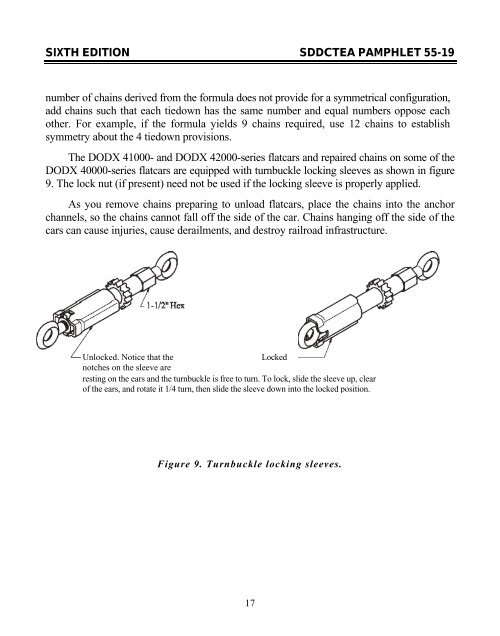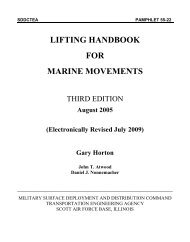Tiedown Handbook For Rail Movements - SDDCTEA - U.S. Army
Tiedown Handbook For Rail Movements - SDDCTEA - U.S. Army
Tiedown Handbook For Rail Movements - SDDCTEA - U.S. Army
You also want an ePaper? Increase the reach of your titles
YUMPU automatically turns print PDFs into web optimized ePapers that Google loves.
SIXTH EDITION <strong>SDDCTEA</strong> PAMPHLET 55-19<br />
number of chains derived from the formula does not provide for a symmetrical configuration,<br />
add chains such that each tiedown has the same number and equal numbers oppose each<br />
other. <strong>For</strong> example, if the formula yields 9 chains required, use 12 chains to establish<br />
symmetry about the 4 tiedown provisions.<br />
The DODX 41000- and DODX 42000-series flatcars and repaired chains on some of the<br />
DODX 40000-series flatcars are equipped with turnbuckle locking sleeves as shown in figure<br />
9. The lock nut (if present) need not be used if the locking sleeve is properly applied.<br />
As you remove chains preparing to unload flatcars, place the chains into the anchor<br />
channels, so the chains cannot fall off the side of the car. Chains hanging off the side of the<br />
cars can cause injuries, cause derailments, and destroy railroad infrastructure.<br />
Unlocked. Notice that the Locked<br />
notches on the sleeve are<br />
resting on the ears and the turnbuckle is free to turn. To lock, slide the sleeve up, clear<br />
of the ears, and rotate it 1/4 turn, then slide the sleeve down into the locked position.<br />
Figure 9. Turnbuckle locking sleeves.<br />
17




